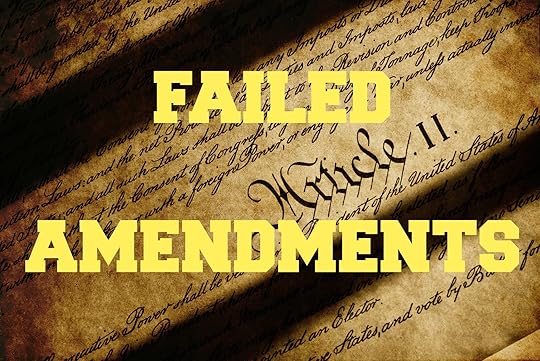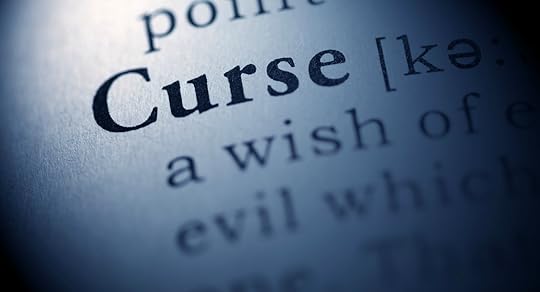Bathroom Readers' Institute's Blog, page 85
May 6, 2016
6 Failed Amendments
It’s very difficult to amend the U.S. Constitution. A potential amendment has to pass both houses of Congress with two-thirds approval, and then it has to be approved by the legislatures of three-fourths of the states. Since 1787, only 27 amendments have been adopted. Numerous others have been proposed…and rejected. Here are some notable rejects.
NO FUNDS FOR CHURCHES
In 1875 President Ulysses S. Grant gave a speech endorsing the use of federal funds to establish public schools nationwide. Maine congressman James Blaine agreed with Grant, but not because he supported public education. He was against parochial schools—Catholic schools (and anything Catholic) in particular. This came on the tail of a large influx of immigrants from Ireland and Italy, two predominantly Catholic countries, and anti-Catholic sentiment in the U.S. was high. That same year, Blaine introduced a constitutional ban on the use of public funds for religious-based organizations. While that may sound like part of the debate over the separation of church and state, Blaine’s real goal was to prevent the Catholic Church from getting any tax money. (Ironically, Blaine actively sought the Catholic vote in his 1884 run for President of the United States, which he lost.)
NO INTERRACIAL MARRIAGE
Like many Americans in the early 1900s, Georgia representative Seaborn Roddenberry felt very strongly about racial integration— he was the leading Congressional advocate for segregation. After African-American boxer Jack Johnson married a white woman in 1912, a public scandal, Roddenberry introduced the Anti- Miscegenation Amendment, which would have made interracial marriage a federal crime.
NO PRESIDENTIAL TERM LIMITS
Franklin Roosevelt was elected to four presidential terms—the Constitution set no limit on the number of terms a president could serve. Prior to that, all presidents had retired after two, a tradition started by George Washington. But Roosevelt and his sweeping program of social welfare were so hated by his Republican opposition that after he died in 1945 and Republicans gained control of Congress in 1947, they passed the 22nd Amendment, limiting the president to two terms. Since 1989, a repeal of that amendment has been proposed several times by members of Congress from both parties, as a way to continue the administrations of popular presidents.
NO AUTOMATIC CITIZENSHIP
It’s set forth in the early pages of the Constitution that anyone born within the borders of the United States is automatically a United States citizen—even if they are the child of illegal immigrants. In 2003 Florida Congressman Mark Foley proposed an amendment to the Constitution that would remove that stipulation. It died in committee. (Foley’s career died after he was accused of having sent sexually explicit instant messages to Congressional pages.)
FEWER RESTRICTIONS TO THE PRESIDENCY
The Constitution forbids foreign-born U.S. citizens from becoming president. This was to prevent anyone from the British empire from ever seizing control of the United States. In 2003 Utah Senator Orrin Hatch proposed the Equal Opportunity to Govern Amendment, which would have allowed any naturalized (foreignborn) American who’d been a legal citizen of the United States for at least 20 years to be president. It was widely seen as a way to eliminate roadblocks for California governor Arnold Schwarzenegger (who was born in Austria) in case he ever wanted to run for the country’s highest office.
NO FLAG BURNING
The Flag Desecration Amendment has popped up for votes frequently since 1968. It would give Congress authority to make it illegal to burn the American flag, an act currently protected as free speech under the First Amendment. Between 1995 and 2005, six different versions of the amendment were passed by the House of Representatives, but it couldn’t clear the Senate. In June 2006, the Senate voted 66–34 in favor of it…just one vote short of the two-thirds majority it needed to go on to ratification by the states.
The post 6 Failed Amendments appeared first on Trivia Books and Facts | Uncle John's Bathroom Reader.
May 5, 2016
Phrase Origins
Here are the origins of some common phrases.
ON THE LAM
Meaning: To be on the run, especially from the police
Origin: “American slang since the latter part of the 19th century. The root of lam is the Old Norse word lamja, meaning to ‘make lame,’ and the original meaning, when it first appeared in English back in the 16th century, was to ‘beat soundly.’ The change in the meaning from beat to run away probably echoed another slang term for running away—beat it. To beat it or lam it is to rapidly beat the road with one’s feet…by running.” (From The Word Detective, by Evan Morris)
STRAW POLL
Meaning: An unofficial vote indicating the trend of opinion on a candidate or issue
Origin: “The use of the phrase began in America in 1824 when reporters from the Harrisburg Pennsylvanian questioned a sample of voters in an attempt to predict the overall result. The findings proved accurate and were considered such a success that the idea caught on and has been used in almost every election ever since. The actual wording of straw poll comes from the practice of throwing a handful of straw into the air to determine the direction of the wind.” (From Red Herrings and White Elephants, by Albert Jack)
THE PITS
Meaning: The worst
Origin: “This disparaging phrase was first linked with Woody Allen in the late 1970s, but was made famous by the 1981 Wimbledon men’s singles tennis champion, John McEnroe. The Wimbledon umpire who failed to accept his outbursts in the spirit in which he offered them was compared to that most unsavory location, ‘the armpits of the world.’” (From To Coin a Phrase, by Edwin Radford and Alan Smith)
HOCUS POCUS
Meaning: Expression used by magicians while performing a trick
Origin: “Before performing sleight of hand, conjurors usually mutter the magical words ‘hocus pocus.’ But they never explain that nonsense phrase. A belief once existed that it came from Latin hoc est corpus, meaning ‘Here is my body,’ used to mock the Roman Church’s mass (in which bread is changed into the body of Jesus).
Word-followers now believe that the phrase was false or invented Latin, fabricated by magicians to sound impressive as they worked their tricks—but the words had no meaning at all. Although the phrase consists of meaningless rhyming sounds, from hocus came the usable words hoax and the slang term hokum, meaning ‘nonsense.’” (From The Story Behind the Word, by Morton S. Freeman)
TO SHELL OUT
Meaning: To hand over money or payment of any kind
Origin: “Money was scarce in Colonial America. Not enough coins and bills were in circulation to meet the demands of commerce. As a result of this shortage, Indian corn was used as a medium of exchange. All payments were in the form of shelled corn. Planters usually left it on the cob until the time came to meet an obligation. So when a bill was due, it was time to get the family together for a husking, a ‘shelling out.’ This practice became so strongly attached to the idea of payment that a person handing over anything of value is said ‘to shell out.’” (From I’ve Got Goose Pimples, by Marvin Vanoni)
BATTING YOUR EYELASHES
Meaning: To flutter one’s eyelids, usually in a flirtatious manner
Origin: “It has nothing to do with bats flapping in a cave, or someone ‘gone batty.’ Batting in this case comes from falconry in Tudor times. According to a book written in 1615: ‘Batting, or to bat, is when a Hawke fluttereth with his wings either from the perch or the man’s fist, striving, as it were, to fly away.’ The old word had long been used by sportsmen, and some American with a lot of Sprachgefûhl—‘feeling for language’—found a fresh use for it in the 1880s.” (From The Facts on File Encyclopedia of Word and Phrase Origins, by Robert Hendrickson)
The post Phrase Origins appeared first on Trivia Books and Facts | Uncle John's Bathroom Reader.
May 3, 2016
I Curse You!
Save these classic curses to use against people who refuse to toast you.
May the curse of Mary Maline and her nine blind children chase you so far over the hills of Damnation that the Lord himself won’t find you with a telescope.
May your daughter’s beauty be admired by everyone in the circus.
May the devil cut the head off you and make a day’s work of your neck.
Six horse-loads of graveyard clay upon you.
May I live just long enough to bury you.
May you be afflicted with the itch and have no nails to scratch with.
All your teeth should fall out except one, and you should have a toothache in that one.
May the seven terriers of hell sit on the spool of your breast and bark in at your soul-case.
May you be transformed into a chandelier, to hang by day and burn by night.
May you win a lottery and spend it all on doctors.
May the devil swallow you sideways.
May you live in a house of 100 rooms, and may each room have its own bed, and may you wander every night from room to room, and from bed to bed, unable to sleep.
May you go stone-blind so that you can’t tell your wife from a haystack.
Your nose should grow so much hair it strains your soup.
May fire and brimstone never fail to fall in showers on you.
May you have devoted children to chase the flies off your nose.
May you back into a pitchfork and grab a hot stove for support.
May those who love us love us. And those that don’t love us, may God turn their hearts, and if He cannot turn their hearts, may He turn their ankles so we’ll know them by their limping.
The post I Curse You! appeared first on Trivia Books and Facts | Uncle John's Bathroom Reader.
May 2, 2016
5 Strange Holidays in May You Ought to Celebrate
May day! May day! We’ve got lots of May days!
May 4: National Candied Orange Peel Day
There’s truly a “holiday” for everything if there’s a day recognizing candied orange peel. These boiled, sliced, and sugared bits of citrus are most commonly found in fruitcake and other winter desserts, so it’s a little perplexing why this day falls in early May.
May 5: National Hoagie Day
Hoagie, hero, sub, Dagwood—call a big, long sandwich with everything on it what you want, but the holidays is officially National Hoagie Day. The best way to celebrate is, of course, to eat a giant hoagie (or hero, sub, Dagwood…)
May 6: International Tuba Day
The first Friday in May is always International Tuba Day. Patented in 1835 in Germany, the tuba is a huge brass instrument that can weight as much as 50 pounds and provides the “bottom end” in marching bands and orchestras. The holiday was created in 1979 by a high school student named Joel Day. He was a tuba player in his Philadelphia high school marching band, and he felt like he and his fellow tuba players didn’t get enough respect.
May 16: Wear Purple for Peace Day
Are you in favor of world peace? Great! Show that you support that cause by wearing purple on this day, and acknowledge anybody else you see wearing purple. But what organizers really intended: If everyone on Earth wears purple at the same time, it creates a collective consciousness, which in turn will signal to extraterrestrials that humans are peaceful and welcoming.
May 23: Sally Ride Day
On May 26, 1951, Sally Ride was born in Los Angeles. A little more than 32 years later, she was onboard the second flight of the Space Shuttle Challenger and became the first American woman in space.
The post 5 Strange Holidays in May You Ought to Celebrate appeared first on Trivia Books and Facts | Uncle John's Bathroom Reader.
April 29, 2016
Robots in the News
Until the day the robots rise up and take us over, stay alert by keeping aware of what they’re up to now.
HER
Hong Kong-based robotics designer Ricky Ma just unveiled his latest creation: Mark 1, a life-size, humanoid robot. Oh, and it looks exactly like actress Scarlett Johansson. It took Ma 18 months and $50,000 to build the electronic ScarJo, most of which was done on a 3-D printer. The robot moves naturally, smiles, and winks. “She” can’t talk, but is programmed to respond to certain comments. If a person tells “her” she’s beautiful, for example, the corners of the robot’s mouth raise up into a coy smile.
ARMED
Biomedical engineer and robot specialist Ortiz Catalan has introduced the most advanced and life-like robotic prosthesis yet. Outfitted onto a Swedish man named Max whose arm was amputated above the elbow in 2013, Catalan’s electrode-studded prosthetic connects into Max’s bones, nerves, and muscles. That means he controls the robotic arm with his brain. With the robotic appendage, Magnus is able to accomplish large tasks (like operate heavy machinery) as well as fine motor skill tasks (like handling an egg).
EXCITED
A new study by scientists at Stanford University found that while humans are still afraid of a robot apocalypse, many also find robots…attractive. In an experiment, humans were matched up with a two-foot-tall humanoid robot. The robot then instructed the volunteer to touch a part of its body, and would then state the medical term for that part. This was done 13 times on 13 parts. When the humans’ vital signs were studied during each set of instructions, scientists found that they elicited physiological responses consistent with arousal when told to touch the robot’s nether-regions.
The post Robots in the News appeared first on Trivia Books and Facts | Uncle John's Bathroom Reader.
Haunted Castles, Mansions and Estates of the U.K.
For some reason, Great Britain has more than its share of mansions, estates, and old homes that are reported to be haunted.
Leeds Castle…
is said to be haunted by a dog. He pays no attention to the people who visit the castle, but he’s said to bring bad luck to anyone who spots him.
St. Donat’s Castle…
is a 12th-century Welsh castle that’s now a boarding school…and they say a ghost-panther stalks the corridors. In a parlor, a piano plays itself…even when the lid is closed.
Woburn Abbey…
in Bedfordshire supposedly has a mischievous spirit that loves to fling open doors. Billionaire J. Paul Getty said it once terrified him by barging into his room.
Chatham House…
is haunted by the ghost of “Hanging Judge” George Jeffreys, the former chief justice of England who liked to hand out death sentences. Jeffreys is said to walk around Chatham House in his black judicial robes, carrying a bloody bone.
East Riddlesden Hall…
in Yorkshire hosts the “Grey Lady.” She reportedly paces up and down the stairs, looking for her lover, who was sealed in a room by her jealous husband and left there to die.
Dover Castle…
is said to be haunted by a boy murdered during the Napoleonic Wars. The headless ghost stalks the halls, drumming.
Raby Castle…
near Durham is the home to the “Old Hellcat”—a ghoulish old woman who sits in a chair, knitting. (If you get close enough, you can feel the heat coming off her glowing-red needles.)
The Kylesku Hotel…
in the Scottish Highlands has a ghost who likes to pop his head through a trapdoor in the ceiling. They say he’s friendly—he only does it to startle visitors.
Inverawe House…
a hotel in Scotland, has “Green Jean.” Instead of trying to scare people, he actually assists the staff, leaving fresh soap and clean towels for the guests.
At Berry Pomeroy Castle…
the “White Lady” haunts the dungeon and towers. It’s supposedly the ghost of Lady Margaret Pomeroy, who was imprisoned in the dungeon by her sister for 20 years and starved to death. People who see her report feeling a wave of depression and fear.
Rufford Old Hall…
in Lancashire is haunted by a young woman in a wedding dress who, the legend says, waits for the return of her fiancé, who was killed in battle. The dining room is also reportedly haunted by Queen Elizabeth I.
Netley Abbey…
a semi-demolished medieval nunnery in Hampshire, is haunted by the ghost of Walter Taylor, a builder hired to tear it down. A stone from an arch struck him on the head and killed him. The demolition was never completed, and now Taylor’s spirit wanders around the ruins accompanied by the sound of falling bricks.
The post Haunted Castles, Mansions and Estates of the U.K. appeared first on Trivia Books and Facts | Uncle John's Bathroom Reader.
April 28, 2016
What’s the Most Unpopular Item in Fast Food History?
The answer: basic math.
Since its introduction in 1972, McDonald’s Quarter Pounder sandwich had been one of its most popular menu items. The name comes from how the meat patty weighs a quarter of a pound (or four ounces) before cooking, much larger than the two-to-three ounce patty used on the chain’s regular hamburgers. In 1980, A&W tried to up McDonald’s by offering an even bigger, meatier burger: the Third Pounder, made with 1/3 of a pound of beef, and priced about the same as a McDonald’s Quarter Pounder. Market research and focus group testing indicated that customers would flock to A&W for the new burger, but it ultimately flopped. Confused, A&W sent corporate representatives to interview A&W customers. The findings: customers thought that a third of a pound was less than a quarter of a pound, and that they were getting ripped off by paying the same for less meat than they would at McDonald’s.
Almost 20 years later, that marketing and math mistake had been long forgotten. With big fanfare and a launch on the Today show, in 2007 McDonald’s introduced the Angus Third-Pounder. Not so surprisingly, the burger—the biggest McDonald’s offered—was off the menu in a year. Perhaps the company thought that “Angus” was the troublesome word (it’s a type of high-quality beef). In 2015, the company unveiled the Sirloin Third Pounder. That one didn’t last either.
The post What’s the Most Unpopular Item in Fast Food History? appeared first on Trivia Books and Facts | Uncle John's Bathroom Reader.
April 25, 2016
6 Songs You Probably Didn’t Know Were Written by Prince
The late Prince was a prolific singer-songwriter, writing and performing dozens of hit songs for himself. But he wrote so much material that he couldn’t record it all himself (or he didn’t feel it was right for him). Here are some Prince songs best known for not being “Prince” songs.
The Bangles, “Manic Monday”
Prince caught a show in Los Angeles by the rock band the Bangles in the early ‘80s when the band was just starting to perform live. He reportedly developed a crush on lead singer Susanna Hoffs, and went into the studio to write and record a song just for her. Prince sent the Bangles the demo, and they re-recorded it. It went to #2 on the pop chart.
Stevie Nicks, “Stand Back”
While on a road trip in 1982, the Fleetwood Mac singer became transfixed with Prince’s 1982 hit “Little Red Corvette,” particularly the keyboard parts. The soulful way he used a sometimes robotic instrument inspired Nicks to write a keyboard driven song of her own called “Stand Back.” Nicks got ahold of the reclusive Prince (which she could do…because she was Stevie Nicks), he was so honored that he met with Nicks and helped her finish writing the song…including some more keyboard parts.
Chaka Khan, “I Feel For You”
Chaka Khan hadn’t had a hit since 1978. In 1984, she had a #3 hit with “I Feel For You.” Suggested by her producer Arif Mardin, it’s a cover of a little-known Prince song from 1979, when he was just starting out. (He wrote it about another R&B star he was trying to date: Patrice Rushen, best known for the hit “Forget Me Nots.”)
Kenny Rogers, “You’re My Love”
Prince was nothing if not versatile. In 1986, he even recorded a country song. Writing under the pseudonym “Joey Coco,” he wrote a song for, surprisingly enough, Kenny Rogers.
Sinead O’Connor, “Nothing Compares 2 U”
The Prince-style abbreviated spelling is a big clue that this was not originally written for O’Connor. Prince wrote it in 1985 for the Family, a side project consisting of individual musicians he’d worked with on other recordings. The Family’s version was never a single and remained relatively obscure. Not O’Connor’s. It spent four weeks at #1.
Tevin Campbell, “Round and Round”
Prince gets a few cents every time Top Chef airs. Why? The cooking competition show samples Tevin Campbell’s 1990 hit “Round and Round.” Prince wrote and produced the song, which appeared on the soundtrack for Prince’s movie Graffiti Bridge.
The post 6 Songs You Probably Didn’t Know Were Written by Prince appeared first on Trivia Books and Facts | Uncle John's Bathroom Reader.
Weird Game Shows
Here are some of the strangest game shows ever to air on American television.
ACROSS THE BOARD (1959)
Concept: Two contestants competed to see who could finish a crossword puzzle first. (Have you ever watched somebody else fill out a crossword puzzle? It’s pretty boring.)
LUCKY PARTNERS (1958)
Host Carl Cordell read part of the serial number on a dollar bill. Players in the studio—and viewers at home—won prizes if they had a dollar bill with matching numbers. Because of the large number of bills in circulation, there were rarely any winners on Lucky Partners.
CELEBRITY BOWLING (1971)
That’s pretty much it: Celebrities came on and bowled. Frequent guests included Telly Savalas, Roy Rogers, Bobby Darin, Carroll O’Connor, and Sammy Davis Jr. Amazingly, the show ran for seven years and inspired a similar show called Celebrity Tennis in 1974.
BALANCE YOUR BUDGET (1952)
Between segments by financial experts who provided budgeting techniques and home economics tips, housewives who were in debt competed to win a treasure chest full of cash.
THE GRUDGE MATCH (1991)
Real people came on to settle a dispute or disagreement in a boxing ring, using “weapons” such as oversized boxing gloves, cream pies, and water balloons. At the end of the show the studio audience voted on a winner.
TRASHED (1994)
Contestants tried to answer questions correctly. If they didn’t, the opposing team got to smash the losing team’s prized possessions with a sledgehammer.
E.S.P. (1958)
Led by host Vincent Price, two contestants were placed in isolation booths, and experiments were conducted to see which person had stronger psychic abilities. After three weeks of shows in which no psychic powers were ever detected, it became a “news” show about E.S.P. (It lasted only a month.)
The post Weird Game Shows appeared first on Trivia Books and Facts | Uncle John's Bathroom Reader.
April 22, 2016
Ask Uncle John Anything: A Bridge Too Far
Uncle John knows pretty much everything—and if he doesn’t, he heads his massive research library, or puts one of his many associates on the case. Here is the answer to a recent question we received.
Why is the Golden Gate Bridge red? Shouldn’t it be gold? Or have a different name?
First of all, the official name of the color used on San Francisco’s most famous landmark isn’t red—it’s “International Orange.” (Still, it looks pretty red to us.) But the reason that the bridge is named the Golden Gate Bridge is because it’s named after something else that was also named after gold.
The bridge spans the Golden Gate Strait, a narrow waterway that connects the San Francisco Bay to the Pacific Ocean. It was so named by Army major-general and California explorer John C. Frémont, who came across the strait on an expedition in 1846. The classically-educated Frémont technically named it Chrysopolae (Latin for “Golden Gate”) because it reminded him of the harbors of Byzantium, or Chrysoceras (Latin for “Golden Horn”) Oddly enough, his name has nothing to do with the California Gold Rush—because that began two years after Frémont’s visit.
And if you’ve ever heard that the bridge over troubled water is so wind-and-water-battered that it has to be repainted end-to-end every year…that’s a myth. Touch-ups are regularly done, but it hasn’t been fully repainted since the ‘80s, when maintenance workers applied a saltwater-resistant topcoat.
The post Ask Uncle John Anything: A Bridge Too Far appeared first on Trivia Books and Facts | Uncle John's Bathroom Reader.





















